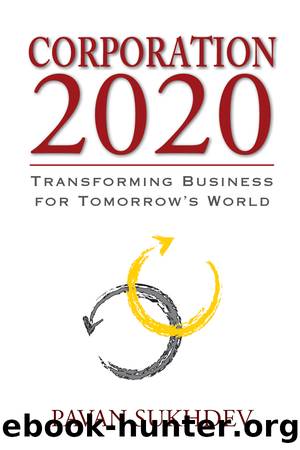Corporation 2020: Transforming Business for Tomorrow's World by Pavan Sukhdev

Author:Pavan Sukhdev [Sukhdev, Pavan]
Language: eng
Format: epub
Tags: Business & Economics, General, Development, Sustainable Development
ISBN: 9781610912389
Google: yAVDLgEACAAJ
Publisher: Island Press
Published: 2012-09-27T23:41:34.159520+00:00
Figure 7-1 Ratio of Structured and Long-Term Debt to Shareholdersâ Equity
Note: Data was obtained in April 2012 for most recent fiscal year, for global public companies with over US$1b in assets and US$1b in revenue (nearly 5,000 companies). Source: Thomson ONE.
A related problem with financial leverage is that when a firm increases the proportion of its assets funded by debt it lowers its share of equity at stake. This distorts incentives further by encouraging more risk-taking behavior. After all, if you have very little skin in the game, you feel better about betting big. If you lose, you stand to lose a small amount compared to the outsized gains you would have made if you had succeeded. This is how leverage has been managed at some large corporations that have failedâlike a betting game on margin.
It is well known that certain industries tend to be predisposed toward utilizing higher financial leverage than others, although there is always variation among individual firms within each industry. Some industries, such as utilities, tend to exhibit higher levels of debt not only because of their large needs for long-term project financing but because their quasi-monopolistic business models afford them relative stability and security of cash inflows. Other industries, such as pharmaceuticals, tend to rely much less on debt, reflecting the higher risk profile of their investments. Any discussion about appropriate levels of leverage should incorporate these sectoral differences in companiesâ borrowing capacity, given that not every firm, and indeed not every industry, is created equal. Figure 7.1 shows the average leverage ratios by industry sector, giving us a sense of the variation in leverage across industries.
Since leverage is hardly managed or controlled in any significant way for nonfinancial corporations, it is only limited by managerial discretion and creditorsâ willingness to lend, with the lending process fraught with pitfalls. In the United States and many other countries, leverage is actually incentivized via the tax deductibility of interest and other types of financial losses. This tips the scale all the more toward nonfinancial corporations seeking leverage and, to the extent there are regulatory gaps, by financial institutions. Despite some controls on leverage found in particular sectors, corporations are given relatively free rein to incur leverage as they see fit.
Toward a New Leverage-Management Framework
Current approaches to managing leverage have resulted in corporations overextending themselves financially and contributed to significant instability in the global economy. Economists recognize the destabilizing effect that leverage can have on the macro economy, and we have seen the negative externalities that it imposes on third parties not involved in the transactions. Our global frameworks for managing leverage at the systemic and corporate level need to change fundamentally. Excessive faith has been placed on the skill and intentions of corporate managers across all sectors, from finance to manufacturing. Markets can provide an efficient first-best solution to many problems, but they often fail when conditions are suboptimal and they do not address disparities in income or wealth distribution. Policy is necessary to address market shortcomings, and the tools to improve our risk-management performance are within reach.
Download
This site does not store any files on its server. We only index and link to content provided by other sites. Please contact the content providers to delete copyright contents if any and email us, we'll remove relevant links or contents immediately.
Zero to IPO: Over $1 Trillion of Actionable Advice from the World's Most Successful Entrepreneurs by Frederic Kerrest(4223)
Machine Learning at Scale with H2O by Gregory Keys | David Whiting(4085)
Harry Potter and the Goblet Of Fire by J.K. Rowling(3756)
Never by Ken Follett(3755)
Ogilvy on Advertising by David Ogilvy(3481)
Shadow of Night by Deborah Harkness(3277)
The Man Who Died Twice by Richard Osman(2977)
Book of Life by Deborah Harkness(2850)
Will by Will Smith(2766)
0041152001443424520 .pdf by Unknown(2765)
My Brilliant Friend by Elena Ferrante(2758)
How Proust Can Change Your Life by Alain De Botton(2724)
The Tipping Point by Malcolm Gladwell(2686)
Purple Hibiscus by Chimamanda Ngozi Adichie(2617)
How to Pay Zero Taxes, 2018 by Jeff A. Schnepper(2577)
Hooked: A Dark, Contemporary Romance (Never After Series) by Emily McIntire(2480)
Rationality by Steven Pinker(2268)
Borders by unknow(2203)
Can't Hurt Me: Master Your Mind and Defy the Odds - Clean Edition by David Goggins(2135)
